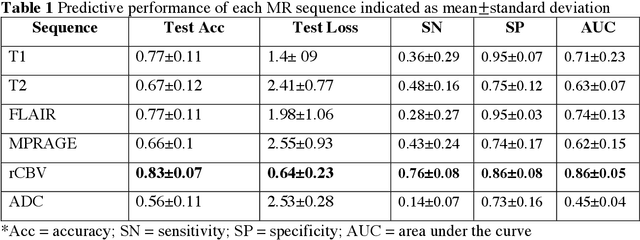Deep learning can differentiate IDH-mutant from IDH-wild type GBM
Paper and Code
Feb 24, 2021
Background: Distinction of IDH mutant and wildtype GBMs is challenging on MRI, since conventional imaging shows considerable overlap. While few studies employed deep-learning in a mixed low/high grade glioma population, a GBM-specific model is still lacking in the literature. Our objective was to develop a deep-learning model for IDH prediction in GBM by using Convoluted Neural Networks (CNN) on multiparametric MRI. Methods: We included 100 adult patients with pathologically proven GBM and IDH testing. MRI data included: morphologic sequences, rCBV and ADC maps. Tumor area was obtained by a bounding box function on the axial slice with widest tumor extension on T2 images and was projected on every sequence. Data was split into training and test (80:20) sets. A 4 block 2D - CNN architecture was implemented for IDH prediction on every MRI sequence. IDH mutation probability was calculated with softmax activation function from the last dense layer. Highest performance was calculated accounting for model accuracy and categorical cross-entropy loss (CCEL) in the test cohort. Results: Our model achieved the following performance: T1 (accuracy 77%, CCEL 1.4), T2 (accuracy 67%, CCEL 2.41), FLAIR (accuracy 77%, CCEL 1.98), MPRAGE (accuracy 66%, CCEL 2.55), rCBV (accuracy 83%, CCEL 0.64). ADC achieved lower performance. Conclusion: We built a GBM-tailored deep-learning model for IDH mutation prediction, achieving accuracy of 83% with rCBV maps. High predictivity of perfusion images may reflect the known correlation between IDH, hypoxia inducible factor (HIF) and neoangiogenesis. This model may set a path for non-invasive evaluation of IDH mutation in GBM.
 Add to Chrome
Add to Chrome Add to Firefox
Add to Firefox Add to Edge
Add to Edge